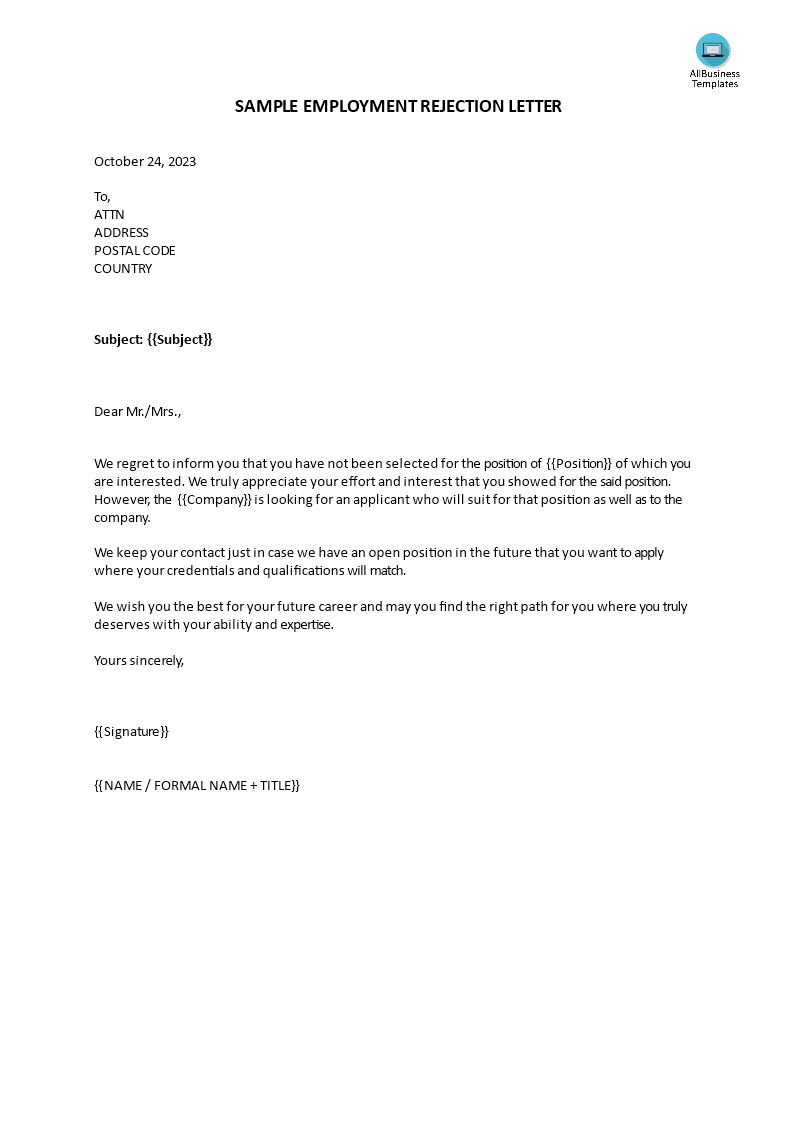Employment Offer Rejection Letter
Save, fill-In The Blanks, Print, Done!

Download Employment Offer Rejection Letter
Microsoft Word (.docx)Or select the format you want and we convert it for you for free:
- This Document Has Been Certified by a Professional
- 100% customizable
- This is a digital download (23.78 kB)
- Language: English
- We recommend downloading this file onto your computer.
How to write an employment offer rejection letter? How do you respond to a rejection letter after a job offer has been made? Our templates are fully customizable and can be tailored to fit your specific situation. We also have sample letters to give you an idea of what your letter should look like. Download this employment offer rejection letter template now!
An employment offer rejection letter is a formal written communication that an individual sends to an employer or hiring manager to decline a job offer they have received. This letter conveys the applicant's decision to turn down the offer in a professional and respectful manner. It's an important step in the job application process, as it allows the applicant to decline the offer gracefully while maintaining a positive relationship with the employer.
Here are the key components typically included in an employment offer rejection letter:
- Date: Include the date when you are writing the letter.
- Employer's Information: Address the letter to the hiring manager or the person who extended the job offer. Mention their name, job title, and the name of the company.
- Salutation: Use a formal salutation, such as "Dear [Hiring Manager's Name]" or "Dear [Company Name] Hiring Team."
- Gratitude: Begin the letter by expressing gratitude for the job offer and the opportunity to join the company. This demonstrates appreciation for the offer.
- Decision to Decline: Clearly and directly state your decision to decline the job offer. It's essential to be straightforward and unambiguous in your language.
- Reason for Rejection (Optional): While not always necessary, you may choose to briefly mention the reason for your decision. This can be personal, such as another job offer, a change in circumstances, or a change in career plans. It's not mandatory to provide this information.
- Appreciation for the Process: Acknowledge the recruitment process, any interactions you had with the company, and the professionalism of the staff. This shows that you have respect for the company and its team.
- Interest in Future Opportunities (Optional): If you are open to the possibility of considering future positions with the company, express your interest in staying connected and exploring potential opportunities down the road.
- Closing: Conclude the letter professionally and express appreciation for the consideration and offer.
- Complimentary Close: Use a formal closing, such as "Sincerely" or "Yours faithfully."
- Signature: Sign the letter by hand if you are sending a printed copy. For electronic submissions, you can use a scanned or electronic signature.
- Contact Information: Provide your current contact information, including your email address and phone number, in case the company needs to reach you for any follow-up or future opportunities.
It's important to send the employment offer rejection letter as soon as you have made your decision. This allows the employer to proceed with their search for a suitable candidate promptly. Additionally, responding in a timely and professional manner maintains a positive impression of you in case you consider applying to the same company in the future or cross paths with the same hiring manager in your career.
Download this HR Employment Offer Rejection Letter template now!
Also interested in other HR templates? Browse through our database and have instant access to hundreds of free and premium HR documents, HR forms, HR agreements, etc
DISCLAIMER
Nothing on this site shall be considered legal advice and no attorney-client relationship is established.
Leave a Reply. If you have any questions or remarks, feel free to post them below.
Related templates
Latest templates
Latest topics
- Excel Templates
Where do I find templates for Excel? How do I create a template in Excel? Check these editable and printable Excel Templates and download them directly! - GDPR Compliance Templates
What do you need to become GDPR compliant? Are you looking for useful GDPR document templates to make you compliant? All these compliance documents will be available to download instantly... - Google Docs Templates
How to create documents in Google Docs? We provide Google Docs compatible template and these are the reasons why it's useful to work with Google Docs... - IT Security Standards Kit
What are IT Security Standards? Check out our collection of this newly updated IT Security Kit Standard templates, including policies, controls, processes, checklists, procedures and other documents. - Letter Format
How to format a letter? Here is a brief overview of common letter formats and templates in USA and UK and get inspirited immediately!
cheese

